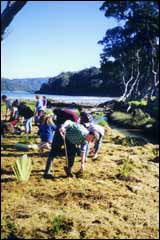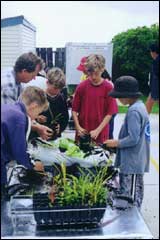|
|
|||
|
||||
|
Updated: September 18, 2001 |
|
|
|||||||||||||||||||||||||||||||||||||||||||||||||||||||||||||||||||||||||||||||
 Riperian (riverbank) planting beside Mulberry Grove School at Tryphena |
|
 School children help with the potting out of native seedlings in March 2001 |
The Department of Conservation manages Great Barrier Island as a separate ecological area. It has high conservation values as there is a lot of undisturbed forest cover. The shoreline ecosystems are mostly intact. The 18500ha under DoC care is divided into 48 separate areas, which are located in the central and northern parts of the island. This is 2/3 of the island's land area, the rest is privately owned.
Great Barrier's large size and diverse plant life has many habitats suitable for a wide variety of animals. Conservation plans and programmes focus on the rare and endangered species present on the island. It is home to birds such as the brown teal and the black petrel and also to a wide range of native skinks and geckos. Endangered plants such as the prostrate kanuka (that lies on the ground) and the Great Barrier Tree Daisy are monitored and protected.
Many of the residents take time to work in beach and landcare conservation groups. Some residents have initiated mainland islands in their own land on Great Barrier. The Little Windy Hill Company has established a Mainland Island between Medlands beach and Rosalie Bay.
Schools on the island have been involved with projects to raise and plant sand tussock.
The ocean boundaries provide protection from introduced predators. Domestic animals can be a problem to some of the ground dwelling birds and lizards on the island. Dogs must be on a leash at all times and cat owners are encouraged to spay or neuter their pets. Feral pigs are monitored and goats are being eradicated.